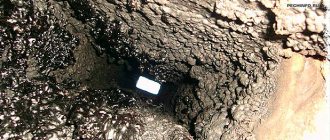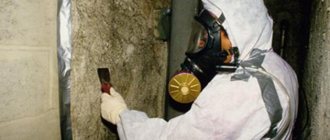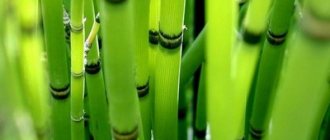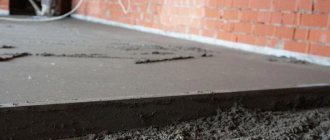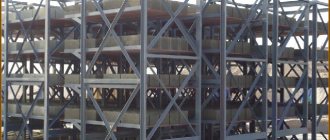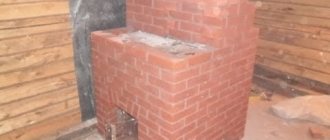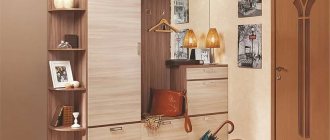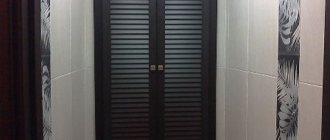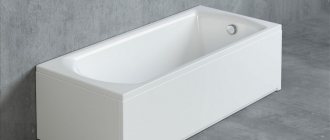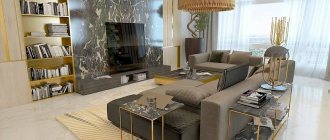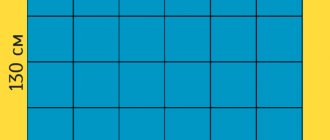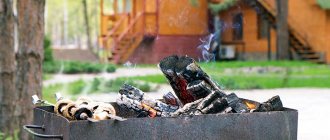Main technical characteristics
Cement-bonded particle boards are made from crushed wood chips and cement, adding substances to the composition that completely eliminate the conflict of materials. The raw materials are laid one by one, forming a multi-layer sheet with special properties, which is formed by a hydraulic press.
As a result, DSPs have the following characteristics:
- Sound insulation indicators – up to 45 dB.
- The change in standard sizes during prolonged exposure to a humid environment is no more than 0.3-2%.
- Bending and tensile strength – 2,500-3,000 MPa, respectively.
- Fire safety – class G1 (low-flammable materials).
- The average service life is up to 50 years.
| Density, kg/m3 | 1300 |
| Humidity , % | 9 +/- 3 |
| Water absorption in 24 hours, % no more | 16 |
| Swelling in thickness over 24 hours, % no more | 2 |
| Biostability, class | 4 |
| Roughness of plates Rz according to GOST 7016-82 for unpolished plates, microns, no more | 320 |
| Maximum deviations in length and width, mm | +/- 3 |
| Maximum deviations in thickness for unpolished slabs 10 mm thick, mm | +/- 0,6 |
| Maximum deviations in thickness for unpolished slabs with a thickness of 12.16 mm, mm | +/- 0,8 |
| Maximum deviations in thickness for unpolished slabs with a thickness of 24 mm, mm | +/- 1,0 |
| Maximum deviations in thickness for unpolished slabs with a thickness of 36 mm, mm | +/- 1,4 |
| Frost resistance (decrease in bending strength after 50 cycles), % no more than | 10 |
| Tensile strength perpendicular to the plate, MPa, not less | 0,4 |
| Hardness, MPa, not less | 45-65 |
| Modulus of elasticity in bending, MPa, not less | 3500 |
| Thermal conductivity, W, (m/С°) | 0,26 |
| Vapor permeability coefficient, mg/(m h Pa): | 0,03 |
It is worth noting that DSP boards are resistant to temperature changes, are easy to process and are not susceptible to mold formation. Disadvantages include dependence on environmental humidity: if the material is in contact with water for a long time, the service life is reduced to 15 years.
Is it burning or not?
The combustibility of a material is one of the key issues of interest to builders and finishers. Considering that the composition includes wood, cement particle boards can catch fire, however, this requires prolonged exposure to high temperatures.
If you are in a completely blazing house, the DSP needs to be in contact with the fire for at least an hour before it ignites . In addition, the material does not contain active chemical components, so even in the event of a fire, there is no risk of poisoning from combustion products.
Application of cement bonded particle boards
Today, cement-bonded particle boards are quite in demand. They are used in the construction of partition walls, insulation of premises, as well as in laying floors, erecting fences, and building frame houses.
Facade works
The reliability of the material and moisture resistance allows it to be used when finishing the facade of a building. They can be used to cover the front door on both sides. This will make it possible to retain heat and prevent the penetration of loud sounds, and will also make the door leaf fire resistant. One such slab can withstand fire for an hour.
Cement-wood material is also used in the construction of balconies. DSP fencing is durable.
Sometimes boards are made from slabs, which are laid at the bottom of the window opening. Such window sills are quite cheap, smooth and easy to adjust to size. In addition, there are no joints on them.
Thermal insulation
Typically, the material is used for insulation of both residential buildings and various structures (garages, basements). To ensure high-quality thermal insulation, install a lathing made of bars or metal profiles with cells of 50X50 cm or 50X80 cm, according to the thickness of the DSP.
A slab with a thickness of 12-16 mm is suitable for thermal insulation work. The distance between them should be 5-10 mm; the gaps are filled with mastic or a special gasket for insulation.
When frame houses are erected, the slabs are attached to the sheathing with self-tapping screws, nails or screws. The sheathing itself is installed flush against the base. The space between the outer and inner slabs is filled with mineral insulation.
When constructing warehouses or non-residential buildings, when thermal insulation is not required, the void between the slabs is not filled.
Finishing work
Since cement particle board is an environmentally friendly material, it is actively used in interior decoration. With their help, walls are leveled for further covering. This type of slab can be plastered, painted, covered with ceramics or covered with wallpaper.
Partitions are also constructed from DSP, which are resistant to moisture. They are used to separate bathrooms in public buildings. To extend the service life, moisture-resistant paint is applied to the partition, and the edges are coated with a moisture-repellent agent.
Laying the floor surface
The floor is laid with cement particle boards according to the same scheme as chipboard. First, 50x80 mm logs are placed at a distance of 60 cm. Afterwards, slabs from 20 to 26 mm are placed on them. They can be used both as a base for the floor and as an auxiliary material for leveling.
DSP can be paved directly onto the ground surface when arranging warehouses or outbuildings. This can be done at any time of the year, and this technique will save money.
Roof formation
When arranging a roof, waterproofing is an important point. Therefore, even when using DSP, you need to do everything extremely carefully so that water does not get inside the roofing material, as this is fraught with the formation of mold.
To prevent moisture accumulation, the gaps are tightly closed with strips of sheet material and thus form a roofing pie. The technology for its construction from CBPB is the same as for the manufacture of other wood building materials.
Construction of load-bearing structures
To fill the foundation, they create the so-called formwork. If you use DSP during its construction, you can get many advantages. Firstly, the work time is reduced, and secondly, labor costs are reduced and money is saved. Another advantage is that a substance can be applied to the outside of the formwork that will prevent the penetration of moisture. And the high strength will prevent the formwork from deforming when pouring concrete and when it hardens.
Composition of the CBPB board
When producing cement-bonded particle boards, manufacturers are guided by GOST standards that are used for this type of building materials. In particular, the following ratio of components included in the finished product is used:
- Crushed wood shavings – at least 30%.
- Water – 9%.
- Portland cement – at least 58%.
- Additional impurities – 2.5%.
It should be clarified that the percentage of raw materials used must be indicated on the packaging. Here are the data recommended by GOST, which may differ slightly for the products of some manufacturers. However, when choosing a material, you need to focus on the given values: this is the key to the quality and strength of CBPB boards.
Application
The main area of use of this material is to increase the thermal insulation properties and sound insulation of premises. Therefore, the material is often used in private residential buildings and in the construction of commercial and industrial facilities.
Cement particle boards are optimally suited for interior and exterior wall finishing and floor preparation for finishing. In addition, the material is often used for arranging interior partitions.
Regardless of the scope of application, DSPs are guaranteed to withstand the service life declared by the manufacturer, which is about 50 years !
Application area
The use of cement bonded particle board is determined by all the properties described above. It is especially valuable that the qualities complement each other, since not all materials combine environmental friendliness, strength, moisture resistance, fire safety and relatively low weight. The form of the material in the form of plates provides another advantage - manufacturability and ease of use. The use of DSP speeds up work, eliminates “wet processes” that require a high level of professionalism when performing and take a lot of time.
The use of such plates is reduced to installation work; the large sizes of the sheets make it possible to cover large areas at once and simplify the alignment of planes.
Cladding of partitions and walls
Cement particle boards are excellent for covering walls, both frame and solid. Due to environmental safety, this is an excellent material for interior decoration, and moisture resistance makes it possible to use them in wet rooms and for exterior decoration. The slabs can be fixed to brick walls, and this method is called “dry plaster”. Cladding with slabs makes it possible to easily obtain a flat surface. Given the simplicity of the work, the labor intensity is much lower than with standard plastering. For this, sheets with a thickness of 0.85 to 1.2 cm are used.
This is the optimal material option for frame construction. The fact is that the technology involves sheathing with sheets, and this ensures high manufacturability and time savings. One of the types in the frame structure will be an internal partition. DSP will play the role of a soundproofing material, which will reduce the acoustic connection between rooms with a partition. To cover the frame you will need slabs with a thickness of up to 2 cm.
Suspended facade systems
One of the natural ways to use DSP is to create a suspended ventilated facade. Such sheets will serve as an outer skin that protects the inner layer from wind and moisture. For a ventilated facade, strength, fire safety and moisture resistance of the material are important. The DSP will withstand mechanical loads well, will not deteriorate from water and will not catch fire. Use slabs with a thickness of up to 1.2 cm.
Roof
DSP is often used to create flat roofs. The sheets should be laid on top of the insulation and then covered with a waterproofing membrane. Due to the rigidity of the slabs, the insulation is not subject to heavy loads and you can even walk on the roof or use it as a summer cafe/recreation area. Depending on the roof loads, slabs with a thickness of up to 2 cm, and sometimes more, can be used.
Floors
Cement-bonded particle board is also often used for flooring, as it is bending-resistant and moisture-resistant. This material is ideal for creating a subfloor, namely a dry screed. Instead of laying a layer of sand-cement mixture on the floor, smoothing it and waiting, it is better to lay DSP slabs on previously prepared beacons and immediately get a base ready for finishing, which will also play the role of a heat insulator. When choosing thickness, pay attention to the calculated loads and density of the insulation material. For a subfloor, the slabs must be no less than 1.4 cm thick.
For frame buildings or when creating a floor using joists, thicker slabs should be chosen. The selection of thickness will be determined by the upcoming load and distance. A frequently used design is a floating floor, for which DSP is also ideal.
Formwork
Typically, in monolithic construction, the formwork is a temporary structure that will be removed after the concrete has hardened. The use of DSP makes it possible to combine preparation and finishing work. Such slabs will make excellent permanent formwork, which will then remain as part of the walls, and will immediately help to form a flat surface that will not require plastering.
Standard sizes
As already mentioned, CBPB slabs are manufactured in strict accordance with GOST standards, and accordingly have strictly defined external parameters. If we talk about standards, the following sizes apply here:
- Sheet length – 2,700/3,200/3,600 mm.
- Width – 1,200-1,250 mm.
- Thickness – 8-36 mm.
| Dimensions, mm | Sheet area, m2 | Sheet weight, kg | Sheet volume, m3 | Number of sheets in 1m3, pcs | Number of sheets in a pack, pcs | Weight 1m3, kg |
| 2600*1250*10 | 3,25 | 42,25 | 0,03325 | 30,77 | 62 | 1300 |
| 2600*1250*12 | 3,25 | 50,7 | 0,039 | 25,64 | 52 | 1300 |
| 2600*1250*16 | 3,25 | 67,6 | 0,052 | 19,23 | 40 | 1300 |
| 2600*1250*24 | 3,25 | 101,4 | 0,078 | 12,82 | 27 | 1300 |
| 2600*1250*36 | 3,25 | 152,1 | 0,117 | 8,55 | 17 | 1300 |
| 2700*1250*8 | 3,375 | 35,1 | 0,027 | 37,04 | 83 | 1300 |
| 2700*1250*10 | 3,375 | 43,88 | 0,03375 | 29,63 | 66 | 1300 |
| 2700*1250*12 | 3,375 | 52,65 | 0,0405 | 24,69 | 55 | 1300 |
| 2700*1250*16 | 3,375 | 70,2 | 0,054 | 18,52 | 42 | 1300 |
| 2700*1250*20 | 3,375 | 87,75 | 0,0675 | 14,8 | 20 | 1300 |
| 2700*1250*24 | 3,375 | 105,3 | 0,081 | 12,35 | 28 | 1300 |
| 2700*1250*36 | 3,375 | 157,95 | 0,1215 | 8,23 | 18 | 1300 |
| 3200*1250*8 | 4 | 42,6 | 0,032 | 31,23 | 84 | 1300 |
| 3200*1250*10 | 4 | 52 | 0,04 | 25 | 66 | 1300 |
| 3200*1250*12 | 4 | 62,4 | 0,048 | 20,83 | 55 | 1300 |
| 3200*1250*16 | 4 | 83,2 | 0,064 | 15,63 | 42 | 1300 |
| 3200*1250*20 | 4 | 104 | 0,08 | 12,5 | 33 | 1300 |
| 3200*1250*24 | 4 | 124,8 | 0,096 | 10,42 | 28 | 1300 |
It is necessary to clarify that this data is relevant only for products from domestic manufacturers. The European construction market has different standards.
Sheet weight
In the table above, the data is shown in a separate column. The weight of the sheet directly depends on two fundamental factors: thickness and area of the product. At the same time, the length and width of the sheet are usually standard; only the thickness changes, which largely determines the performance characteristics and scope of application. Let's look at the change in the weight of a standard sheet (3,200 * 1,250 mm) depending on the thickness. It looks like this:
- Thickness 10 mm – weight 54 kg.
- 12 mm – 64.8 kg.
- 16 mm – 80 kg.
- 20 mm – 108 kg.
The weight of the densest sheets can reach up to 194 kg , however, such material is very inconvenient for independent work. For cladding walls and arranging interior partitions, sheets with a thickness of 16-20 mm .
Video description
About fastening the DSP to a wooden floor - in the following video:
Formwork
This composite has proven itself to be excellent when installing permanent formwork. In most cases, in the construction of monoliths, the formwork is removed after the concrete has set and the walls are finished with additional materials. DSP simplifies this process by becoming part of the wall and immediately providing a smooth surface ready for painting. The need for plaster, in this case, disappears.
Permanent formwork made of CBPB Source tildacdn.com
Garden paths
A rather unusual use of the material is the arrangement of garden paths. Meanwhile, this decision is not the worst. The capabilities of the slabs allow them to be laid on a prepared sand bed without fear of mowing and cracking. Of course, to compensate for seasonal soil movements, it is necessary to prepare a high-quality drainage layer.
How to cut this material
It’s worth clarifying right away that it is better to cut cement particle boards in production shops: the work is very dusty and requires a special tool for an even cut. At home, you can use the following devices:
- Hand cross saws.
- Machine hacksaws.
- Circular saws.
- Bulgarians.
- Jigsaws.
The working surface of the tool must be made of carbide materials, the rotation speed of circular saws: no more than 200 rpm .
To minimize room contamination and reduce the amount of dust, it is recommended to spray the surface of the material being cut with water and prepare a vacuum cleaner to suck up fine particles.
List of verified manufacturers
On the Russian market, there are several proven companies producing high-quality products that meet GOST standards. When choosing a DSP, you can pay attention to the following manufacturers:
- JSC "TAMAK " The company is located in the Tambov region, producing cement-bonded particle boards in accordance with domestic and European standards (EN 634-2). The products are solid monolithic sheets without the slightest defects.
- LLC "TsSP-Svir " The company operates in the Leningrad region, filling the market with quality products. Characteristic features of the finished sheets: polished or calibrated surface of light gray color. The production uses German equipment, which ensures the production of CBPB boards in accordance with Russian and European standards.
- JSC "MIT " The company's production line is located in the Kostroma region. The finished sheets have a clear geometry, meet Russian quality standards, and are sold in an affordable price segment.
- LLC "Stropan " The company operates in the Omsk region. The main characteristics of the finished sheets look like this: thickness from 10 to 36 mm while maintaining standard dimensions, elasticity of the material - 3,000 MPa, excellent thermal conductivity and sound insulation.
- ZSK LLC . The company is located in the city of Sterlitamak, Republic of Bashkortostan. The manufactured products have standard sizes corresponding to GOST, and are resistant to aggressive environmental influences and temperature changes.
It is important to clarify that all Russian companies producing cement-bonded particle boards use equipment from Western manufacturers. This helps to produce high-quality products at reasonable prices.
What is the price?
The price of cement particle boards depends on:
- compliance with GOST;
- type of plate (TsSP-1 or TsSP-2);
- quality of processing (polished or unpolished);
- sheet size and weight.
Material that complies with GOST 26816-86 is always more expensive than that made without regard to this document. To some extent, the indication of GOST 26816-86 in the name of a building material is synonymous with a quality mark , regardless of the place of manufacture of the slab. We have prepared a table that includes the most popular manufacturers of chipboards and their official dealers, as well as the price per sheet of their products:
| Manufacturer or seller name | Slab dimensions (length, width, thickness in mm) | Cost in rubles | Cities where production and main representative offices are located |
| Individual entrepreneur Bogdan Vladimir Ivanovich, official dealer of Tomak CJSC in the Krasnodar Territory | 3200x1250x10 | 880 | Production Tambov. Representative offices Moscow, Krasnodar |
| 3200x1250x16 | 1205 | ||
| 3200x1250x20 | 1505 | ||
| 3200x1250x24 | 1665 | ||
| LLC "TsSP-Svir" | 3200x1200x8 | 715 | Production Lodeynoye Pole (Leningrad region). Representative offices Moscow, St. Petersburg |
| 3200x1200x10 | 742 | ||
| 3200x1200x12 | 824 | ||
| 3200x1200x16 | 985 | ||
| 3200x1200x20 | 1255 | ||
| 3200x1250x10 | 817 | Manufactured in Moscow. Representative office Moscow | |
| 3200x1250x16 | 1158 | ||
| 3200x1250x20 | 1415 | ||
| 3200x1250x24 | 1654 | ||
| 3200x1250x10 | 1080 | Production Krasnodar. Representative offices Moscow, Sevastopol | |
| 3200x1250x16 | 1430 | ||
| 3200x1250x20 | 1730 | ||
| 3200x1250x24 | 1900 |
As can be seen from the table, the cost of wood-cement boards or panels depends on their size, the thickness of the sheet and, accordingly, its weight, which we talked about earlier: for each thickness indicator - be it 8mm, 10mm, 12mm, 16mm, 18mm, 20mm, 24mm or any other will have its own price per sheet or per m2 of material.
In addition, an unsanded slab with a thickness of 10 mm or 12 mm will cost less than a sanded slab of similar sizes.
Useful to know during installation
It must be remembered that you need to work with cement particle boards very carefully: the large area of the sheet makes it fragile, so installation is carried out by at least two people.
In addition, CBPB boards are not laid closely; expansion joints must remain. The material contains wood, which tends to expand under the influence of a humid environment. Given this feature, it is not recommended to fill joints with putty. It is better to use a sealant that will not interfere with the expansion of the DSP boards.
Is there any harm to health?
The development of the chemical industry has led to the emergence of inexpensive but hazardous building materials.
Many types of plywood, chipboard and OSB are harmful to health - they emit formaldehyde and other toxic substances, so it is undesirable to use them for finishing living rooms and children's rooms. Foam and PVC, as well as other types of plastics, when burned, release toxic substances that make it difficult to escape from a burning house.
Cement particle boards
do not emit any toxic substances and are therefore completely safe.
Due to their environmental friendliness, DSP can be used to decorate children's rooms and bedrooms. During a fire, the release of carbon monoxide from the stove is so small that it does not affect the gas composition of the air in the room.
Even the dust released during mechanical processing of slabs is safe when using minimal protective equipment.
All this points to one thing: cement particle board is one of the safest and most environmentally friendly finishing materials, so it can be used for cladding premises for any purpose.
